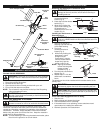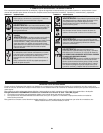
MAINTENANCE AND REPAIR INSTRUCTIONS
SAW CHAIN REPLACEMENT/INSTALLATION
The pole saw chain and bar are expendable items, not covered by
the product warranty. Replacement chain or bar is available for
purchase through Sears parts and repair.
1.
Remove the bar retaining
nuts and screw. Then take off
the chain guard (Fig. 8, B).
2. Using a flat-head
screwdriver turn tension
adjustment screw
counterclockwise (Fig. 8,
A) 4 turns.
3. Take off the chain and bar.
4. Prepare new chain and/or
bar, and fit the chain into
the groove in the bar.
5. Loop the saw chain over
the drive sprocket with the
cutting edges of the chain
pointing in the direction of
rotation (Fig. 9).
6. Adjust the tension
adjustment screw (Fig. 8,
A) to allow insertion of the
bar (Fig. 10). Make sure
the chain follows the slot
in the guide bar and adjust
the tension adjustment
screw to make the chain
fit snugly on the underside
of the bar.
7. Install the chain guard and
tighten bar retaining nuts
and screw (Fig. 8, B).
SAW CHAIN TENSION
ADJUSTMENT
Proper tension of the saw chain is extremely important and must be
checked before starting, as well as during, any cutting operation.
Taking the time to make needed adjustments to the saw chain will
result in improved cutting performance and prolonged chain life.
NOTE: A new chain and bar
will need re-
adjustment after as
few as 5 cuts. This is
normal during the
break-in period, and
the interval between
future adjustments
will lengthen quickly
(Fig. 11).
To adjust the saw chain tension:
1. Loosen the bar retaining nuts so they are hand tight (Fig. 8, B).
2.
Holding the nose of the bar up, use the screwdriver to turn the
guide bar adjustment screw clockwise to tighten the chain (Fig. 8,
A). Turning the screw counterclockwise loosens the chain on the
guide bar.
3. While wearing heavy duty work gloves (after you’ve made the
adjustment), move the saw chain back and forth on the guide
bar to be sure the chain moves freely and is in proper mesh with
the sprocket. Never move the chain with your bare hands.
NOTE:
If the chain is difficult to rotate or if it binds on the guide bar,
there is too much tension applied and it must be adjusted. To
decrease tension, turn the adjustment screw counterclockwise,
slowly. Move the chain back and forth until it moves freely.
WARNING:
Whenever handling the saw chain, always
wear work gloves for protection against sharp cutting edges.
CAUTION:
If a chain is too loose or too tight, the bar chain
and saw bearings will wear more rapidly. Refer to Figure 11 for
information concerning correct cold tension (A), correct warm
tension (B), and a chain in need of adjustment (C).
Chain Guard
Bar Retaining Nuts
Fig. 8
Tension
Adjustment Screw
Slot
Fig. 10
Fig. 11
B
A
Screw
Fig. 9
B
A C
4. Holding the nose in upper position, securely tighten the bar
retaining nuts.
CHAIN LUBRICATION
The pole saw chain is self-lubricating. Oil is dispersed onto the
chain as the unit is used. Keep an adequate amount of oil in the oil
tank. Use the bar-chain oil provided in the hardware pack. Always
use bar-chain and sprocket oil
or similar chain saw oil.
Setting the Oil Adjustment
Screw
The Oil Adjustment Screw is
located on top of the gearbox
assembly (Fig. 12).
1. Insert a 3/32-inch Allen
wrench into the oil
adjustment screw.
2. Turn the screw
counterclockwise to increase oil flow to the chain.
3. Turn the screw clockwise to restrict the oil flow to the chain.
GUIDE BAR MAINTENANCE
NOTE: Proper maintenance of the guide bar is essential to the
performance of your pole saw. Proper guide bar
maintenance will keep your saw in good working order.
Most guide bar problems can be prevented merely by keeping the
chain saw well maintained. Incorrect filing and non-uniform cutter
and depth gauge settings cause most guide bar problems, primarily
resulting in uneven bar wear. As the bar wears unevenly, the rails
widen, which may cause chain clatter and difficulty in making
straight cuts. Insufficient guide bar lubrication and operating the
saw with a chain that is too tight will contribute to rapid bar wear.
Refer to Saw Chain Tension Adjustment and Oiling the Chain. To
help minimize bar wear, the following guide bar maintenance is
recommended:
Bar Wear
Turn guide bar frequently at regular intervals (for example, after 5
hours of use), to ensure even
wear on top and bottom of
bar.
Bar Grooves
Bar grooves (or rails which
support and carry the chain)
should be cleaned if the saw
has been heavily used or if the
saw chain appears dirty. Rails
should always be cleaned
every time the saw chain is
removed.
To clean guide bar rails:
1. Remove chain guard, bar, and chain. Refer to Saw Chain
Replacement / Installation.
2. Using a screwdriver, putty knife, wire brush or other similar
instrument, clear residue from the rails on the guide bar (Fig. 13).
This will keep the oil passages open to provide proper
lubrication to the bar and chain.
3. Ensure the sprocket in the bar turns freely during cleaning.
NOTE: Oil passages at the bar pad should be cleaned to ensure
proper lubrication of the bar and chain during operation.
This should be done while the bar is removed for cleaning.
Oil Adjustment Screw
Fig. 12
Gearbox
Assembly
WARNING:
If the oil tank runs out, the oil ajustment screw
hole becomes clogged, or the chain fails to get proper lubrication
in any fashion, the chain will overheat and cause irreversible
damage to the unit and may result in severe injury. Excessive
heat from friction can lead the chain to catastrophically fail and
come off the bar while operating.
WARNING:
Ensure that the unit is off and the spark plug
is disconnected (gas powerheads) before performing any
maintenance on your saw.
Fig. 13
7


















